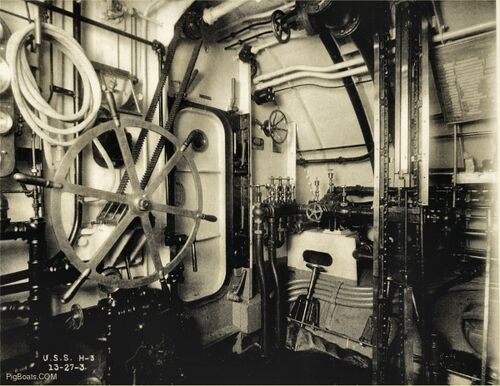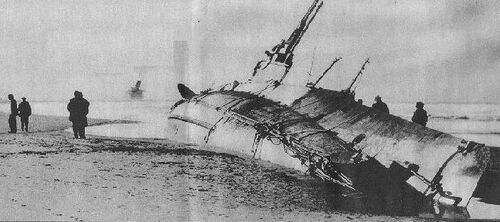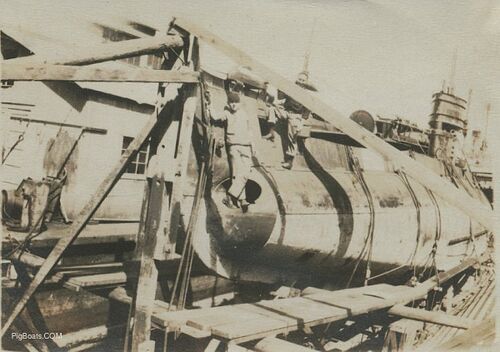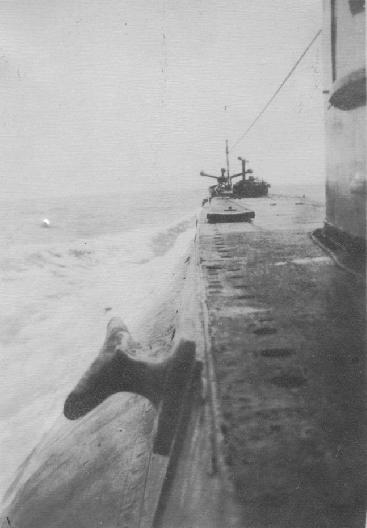H-3
Construction and Trials

Photo courtesy of the National Archives.

The launch of the H-3 from the Moran Company building slip, July 3, 1913.
Image courtesy of the Seattle Post-Intelligencer Newspaper.

H-3 returning from Seattle to Bremerton, WA., March 1914. LT William R Munroe, the Commanding Officer, is on the bridge. H-3 had been refueling in Seattle and was returning to the Puget Sound Navy Yard. There is an unidentified cruiser in the background. The waterway seen is probably Sinclair Inlet as the land in the background (Port Orchard) still looks pretty much today as it does in this photo.
Photo courtesy of the National Archives.

H-3 running trials on Bellingham Bay, north of Seattle near the Canadian border, January 1914. The bay is calm, but the boat is running at a good clip and pushing up a large bow wave.
U.S. Navy photo.

Another view of the Bellingham Bay trials, from the port bow. H-3 had been commissioned at this point, but it appears as though there are several civilians aboard, probably Electric Boat or Moran employees observing the tests.
U.S. Navy photo.
Interior Photos

The H Class subs carried four torpedoes in their tubes and four reloads. These subs fired the Bliss-Levitt Mark 6 torpedo.
Photo courtesy of the National Archives.

H-3's torpedo room looking aft. The curtained areas to port and starboard are berthing for the Captain and Executive Officer. The two swingout stanchions have the notched arms for holding reload torpedoes in line with the tubes.
Photo courtesy of the National Archives.

The H-3's forward battery compartment looking forward. Torpedo tubes can be seen through the open watertight door. the photo is very dark and indistinct with the exception of the lockers and door. Two men can be made out in silhouette but that is about all. A large safe can be seen attached to the bulkhead to the right of the door. There is a fresh water tank on the right with an oval-shaped bolted down access cover.
Photo in the private collection of Ric Hedman.

H-3's forward battery compartment looking aft. The door leads to the Control Room. On the right is a small room that according to the ship's drawings is the radio room. The two large pipes are the ventilation piping for the battery under the deck. This is to help prevent the buildup of hydrogen gas in the battery well and prevent explosions.
Crew bunks are seen at the top in the photo. The bunks to the left have canvas curtains and are a single row of bunks. The bunks on the right are two deep and the inner row has been "triced up", meaning they have been folded away to make room for other functions.
The drawings show that only part of the compartment is paneled and the forward end is not as noted in the photo above this one. The benches are storage lockers for the crew's personal gear. In the lower left corner of the photo is a portable electric heater, the cord for which can be seen draped in the upper left and followed down to the heater.
Unseen in the photo to the left of the door and outboard any paneling is the motor for the trim pump, controls for which are located in the control room. This pump is used to move water around the submarine for ballast and pumping bilges.
Note the tool kit on the bulkhead to the right of the door. It has three open end wrenches, two spanner wrenches, two T-wrenches and at least two screwdrivers. There is one of two possibilities for this kit, the first being for damage control, the 2nd for use by the electricians in the battery well. The presence of the spanner wrenches indicate that this is a damage control kit, as the spanners are used for coupling and decoupling fire hoses. If these are brass tools then it might be a battery well tool kit.
We are yet to discover what the huge wrench under the tool kit is used for. The only reasons we can come up with would involve use in the engineroom.
Photo in the private collection of Ric Hedman.

Control room of the H-3 looking forward and to the starboard corner. The door leads to the forward battery compartment. The helm wheel is in the center, with a mirror so that the helmsman can see the dial of the magnetic compass above him. Note the chain leading up from the helm shaft to a shaft in the overhead that is connected to the rudder rams in the stern. On the right is the ballast control manifold, used to move ballast water to various tanks to balance the foward/aft trim and the boat's overall buoyancy. Directly above the manifold on the forward bulkhead are the controls for the trim pump.
Photo in the private collection of Ric Hedman.

H-3's control room looking to port. On the left are the wheels for controlling the stern planes (left) and the bow planes (right). In between them are the depth gauges and bubble levels. The round hull section beneath the wheels is actually the top of the port side of the auxiliary ballast tank. On the right is the high pressure air manifolds, used to blow ballast tanks to surface the boat.
Photo in the private collection of Ric Hedman.

The H-3's control room is actually a small space, and this view is of the port aft corner. The stern planes wheel can be seen in the center right.
Photo in the private collection of Ric Hedman.

The H-3 after battery compartment. The view is looking aft to the engine room door. This compartment was a combination of crew's berthing, galley, messing, and maneuvering room. The Astern - Stop - Ahead indicators for each engine/motor are on either side of the door. The shaft turns indicators for each shaft are just above the direction indicators. Electrical switching gear can be seen on each side of the compartment. The Galley would be located in the forward port corner of the compartment consisting of a range, sink and a small counter space.
Photo courtesy of the National Archives.

This closeup gives a better view of the equipment on the aft bulkhead in the after battery compartment. This photo appears to have been taken at 5:25 pm indicated by the clock in the upper left corner.
Photo courtesy of the National Archives.

This is a later view of the same scene. It is unfortunate that the photo quality is poor. Through the door on the left can be seen the starboard diesel engine. An electrical panel is on the left where the man is working.
In the overhead on either side of the door can be seen two dark long rods or shafts. The one on the left is the mechanical drive shaft for the rudder. The one on the right is for the operation of the stern planes.
Photo courtesy of Carolyn Fields Snider whose uncle, Harry Fields served on the H-3.

The H-3's engine room looking aft between the two NELSECO Model 240V8FS engines. Between the engines a large vertical tube can be seen. This is the tube that housed the Allied Signal Bell. These used to be mounted on the top of submarines but in later boats this was mounted upside down in a tube with the bell on the bottom. It is believed the H-3 was the last submarine with this feature.
On either side of the tube near the bottom are seen the rounded shapes of the two 600 horsepower main electric motors for charging the batteries and driving the submarine underwater. Above and behind the motors are the two air compressors for charging the air banks. These operate off propeller shaft rotations.
In the overhead can be seen the continuation of the two long control rods or shafts. The one on the left is the mechanical drive shaft for the rudder. The one on the right is for the operation of the stern planes.
Photo courtesy of Carolyn Fields Snider whose uncle, Harry Fields served on the H-3.

The H-3's engine room looking forward between the two NELSECO Model 240V8FS engines. In the foreground are the two 600 Horsepower main electric motors for charging the batteries and driving the submarine underwater. Barely seen at the far end of the compartment, in the glare, is the door into the after battery compartment.
Photo courtesy of Carolyn Fields Snider whose uncle, Harry Fields served on the H-3.
First Grounding and Drydocking

Photo in the private collection of Ric Hedman

This photo was taken later on June 30, 1915 with the tide rising. The monitor USS Cheyenne (Monitor No. 10) was accompanying the boats and was able to get a line to the stricken sub. Cheyenne commenced a very careful pulling operation and she was able to pull H-3 off the rocks later on the 30th. The H-3 and Cheyenne immediately proceeded to San Francisco to inspect the H-3 for damage. What little was found was quickly repaired and the boat was returned to service.
A slight swell can be seen in the waters. The fog also looks to be lifting as the peak behind is now clearly visible.
National Archives photo.

This is a broadside view of the H-3 in drydock at the Mare Island Navy Yard near San Francisco on July 6, 1915. The wrinkling of the bilge keel is evident. Little else appears to be damaged but the drydocking was a good precaution just in case there was unnoticed damages.
Several crew are on deck and seem to reading magazines. A couple of crew are on the dock floor back by the rudder and propellers.
National Archives photo in the private collection of Ric Hedman.

Bow on view of the H-3 in drydock at the Mare Island Navy Yard near San Francisco. The photo is taken July 6, 1915. Her sisters the H-1 and H-2 are participating in the Independence Day Celebrations at the Panama-Pacific Exposition in San Francisco. The H-3 was to be there also but her unfortunate grounding at Point Sur changed all that.
The only visual damage to the submarine seems to be to her starboard bilge keel which has been crumpled by the sub rocking on Point Sur for about 18 hours. The total cost of the damages were listed at $2,500 dollars and several hull plates had to be replaced.
The hooped pipe frame seen sticking out from the bridge side is an outhouse type toilet facility. Though the submarines had a head inside the vessel it was a complicated process to use and flush and the simple outhouse took place of that problem while on the surface. All waste was washed away with the passing sea water.
Early Operations

When Ric Hedman first saw this photo he knew he had to own it due to its interesting nature. It is hard to see but there is a second seagull sitting on a periscope top on the sub behind this one.
These are fixed length, non-retracting periscopes. They do rotate to let the observer check a 360 field of view. Noted that the boat's air whistles are braced to the number 2 (taller) periscope barrel on both subs.
The long skinny flags are U.S. Navy Commissioning Pennants. Once a vessel has been accepted by the Navy it is placed "In Commission" and this pennant, consisting of a blue field with white stars and a single red and a single white stripe with "swallow tail" end is raised on the vessel.
Photo in the private collection of Ric Hedman
Commissioning Pennant US Navy Photo

H-3 (foreground) moored with F-3 (Submarine No. 22) at San Pedro, CA. approximately 1916.
Photo courtesy of Carolyn Fields Snider, whose uncle, Harry Fields served on the H-3.

H-3 seen while at sea. Date and location unknown but probably off the southern California coast approximately 1916-1917. Crew not needed below decks are seated on the after deck getting fresh air and a bit of sun, but in reality they were probably keeping cool from high interior heat.
Photo courtesy of Mike Dilley.

H-3 with her crew on deck for a formal crew photo. Location is thought to be San Diego, CA. circa 1915
Photo courtesy of Bill Lightfoot, author of Beneath the Surface.

H-3 with crew on deck. Location is thought to be San Diego, CA. circa 1915. This is a much more relaxed photo showing the men wearing working uniforms. The man on the bow is holding a heaving line indicating that the sub may be away from the dock either for the photo or just leaving or mooring.
Photo courtesy of Bill Lightfoot, author of Beneath the Surface.
Eureka, California Grounding, December 1916/January 1917

U.S. Navy photo.

H-3 grounded at Samoa Beach near Eureka, CA., January, 1917. A bridle of towing tackle is rigged to the submarine for her attempted rescue by the cruiser Milwaukee that ended in failure. At low tide the H-3 was almost completely out of the water.
U.S. Navy photo.

The H-3 stranded on the beach at Eureka, CA., January 1917. The wreck of the USS Milwaukee can be seen in the background. The attempted rescue of the H-3 by the Milwaukee was a classic case of incompetence and stubborn adherence to protocol. This was a bad day for the Navy. A submarine was stranded and a cruiser wrecked. The H-3 was eventually removed from the beach and put back into service, but the Milwaukee was a total loss. There are some elements of her wreckage still on the beach to this day.
U.S. Navy photo.

Another view of the stranded H-3 on the beach at Eureka, California. Remnants of the towing bridle are attached to the bow.
Photo courtesy of Leszek Erenfeicht who lives in Poland.

The USS Milwaukee (Cruiser No. 21) hard aground on Samoa Beach near Eureka, CA. January 1917. Coxswain T. S. Decker, the first man to leave the Milwaukee, is shown in the breeches buoy. The crew can be seen lined up on deck to be taken off in the same manner or by boat. The Milwaukee was a total loss. The Milwaukee's acting captain, LT William Newton, acted in a rash and uncalculated manner trying to get the H-3 off the beach quickly. His actions directly resulted in the Milwaukee's loss. Despite that, no disciplinary action was ever taken against him.
U.S. Navy photo.
Later Operations, 1917-1922

Photo courtesy of Carolyn Fields Snider, whose uncle, Harry Fields served on the H-3.

Another view of H-3 in drydock in 1919. She has had her hull scraped and cleaned in preparation for painting. Other work is being done on her superstructure. This photo gives a good view of how the bow planes folded back against the superstructure.
Photo courtesy of Carolyn Fields Snider, whose uncle, Harry Fields served on the H-3.

H-3 in dry dock at Mare Island, 1919. The two crewmen are identified as "Bubbles and Van". The man on the left is standing in the opening in the bow cap for a torpedo tube.
Photo courtesy of Carolyn Fields Snider, whose uncle, Harry Fields served on the H-3.

"Bubbles and Van" clowning for the camera with the H-3 in drydock at Mare Island. "Bubbles" is inside the muzzle for #2 torpedo tube.
Photo courtesy of Carolyn Fields Snider, whose uncle, Harry Fields served on the H-3.

Another view of H-3 in drydock at Mare Island in 1919.
Photo courtesy of Carolyn Fields Snider, whose uncle, Harry Fields served on the H-3.

H-3 at sea from the bridge, somewhere off the California coast, approximately 1919. This photo shows good details of the radio antenna insulator.
Photo courtesy of Carolyn Fields Snider, whose uncle, Harry Fields served on the H-3.

H-3 crew on deck and on the conning tower fairwater, circa 1919. Gunner's Mate Long is at the top of the masts. This view is looking forward.
Photo courtesy of Carolyn Fields Snider, whose uncle, Harry Fields served on the H-3.

This innovative photo shows the H-3 at sea in 1919. The view is looking forward along the port side, next to the conning tower fairwater. The object in the foreground is a steel cleat used to secure mooring lines. In the center is the boat's gangplank, used to access the boat from the pier. Further forward the T-shaped SC sonar array can be seen with the three rubber "rats" of the Y-tube sonar visible beyond that.
Photo courtesy of Carolyn Fields Snider, whose uncle, Harry Fields served on the H-3.

In the Submarine Service this is referred to as a "Steel Beach" circa 1919. The H-3's captain has allowed most of the crew to come up on deck to escape the oppressive heat and humidity below.
Photo courtesy of Carolyn Fields Snider, whose uncle, Harry Fields served on the H-3.

H-3 crew members, approximately 1919. Harry Fields is identified as being in the photo. Based on other pictures it appears he is in the front row, third man from left.
Photo courtesy of Carolyn Fields Snider, whose uncle, Harry Fields served on the H-3.

H-3 with what is likely a Bliss-Leavitt Mk 6 torpedo resting on the loading skid during the process of lowering it into the torpedo room.
Photo courtesy of Carolyn Fields Snider, whose uncle, Harry Fields served on the H-3.

Another view of the torpedo loading evolution shown above. The loading skid formed a portion of the main deck. The actual watertight hatch is unseen below the deck. This weapon weighed 1,800 lbs. (616 kg) and required some very careful handling.
Photo courtesy of Carolyn Fields Snider, whose uncle, Harry Fields served on the H-3.

The topside watch on the H-3, a man identified by Harry Fields as "Van", clowns for the camera while at San Pedro in 1919. The "gun" in his hand appears to be a fake. His gun belt and holster however are real. It appears as though the gun belt is set up to carry individual rounds. This makes it likely that his actual sidearm is a revolver. In 1919 this could be a Colt New Service Revolver in .45 ACP.
The USS L-6 (Submarine No. 45) and another unidentified sub are in background.
Photo courtesy of Carolyn Fields Snider, whose uncle, Harry Fields served on the H-3.

This photos shows H-9 (Submarine No. 152) and H-3 (right) in drydock at Mare Island with a housing or work barge between them. The date is approximately 1919-1920.
Photo courtesy of Carolyn Fields Snider, whose uncle, Harry Fields served on the H-3.
Page created by:
Ric Hedman & David Johnston
1999 - 2023 - PigBoats.COM©
Mountlake Terrace, WA, Norfolk, VA
webmaster at pigboats dot com

